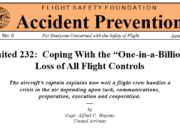Twenty-five years ago, on July 19, 1989, a Douglas DC-10 crash landing in Sioux City, Iowa, U.S., became an archetypal example of successful crew resource management. United Airlines Flight 232 was on its way from Denver to Chicago when the tail-mounted engine exploded approximately 37,000 ft over northwestern Iowa. Separation, fragmentation and forceful discharge of stage 1 fan rotor assembly parts from the no. 2 engine rendered the hydraulics useless. Fortunately, the airplane’s two wing-mounted engines were still operable, as differential thrust was all the crew had to control the airplane.
Capt. Al Haynes alerted his crew to brace 285 passengers for a crash landing. But there was no way to properly prepare the four lap-held children younger than 2, who were unrestrained. As instructed, the parents wrapped their babies in towels and blankets, placed them on the floor and braced them with their hands and legs. This was the protective measure the airlines had in place at the time for the plane’s most precious cargo.
Amazingly, 185 people aboard the plane survived the crash landing and subsequent fire, including lap children recovered by strangers after they were found in the luggage bins of the upside down fuselage. But one child was not found. Not surprisingly, hands, feet, blankets and towels could not restrain the lap children on that flight.
Twenty-five years later, airlines still do not require child restraints.
Juxtapose the aviation exemption from restraints for lap children with the standard of care for children in motor vehicles. Since 1989, there have been significant data-driven paradigm shifts in traffic safety. Today, every state in the United States requires that children be restrained in size-appropriate restraints, and 49 of the 50 states require seat belt use. In 2011, seat belts saved an estimated 11,949 lives, and child restraints saved an estimated 263 lives among children younger than 5, according to the National Safety Council. Because of the efficacy of child passenger restraints, lower anchors and top tethers for children, or LATCH systems, are required in motor vehicles manufactured after 2001.
Passenger restraint improvements have been made in aviation safety since 1989. Today, 16-g dynamic seats are the standard for newly manufactured commercial aircraft, and some seating positions have seatbelt-mounted airbags. However, only general aviation aircraft manufacturers, like Cirrus, have installed LATCH-compatible seats.
In the end, failing to require that all passengers, including children younger than 2, be restrained is a glaring safety gap in what is otherwise a safety-centric industry.
Many are committed to closing that gap. In May, the International Air Transport Association hosted its inaugural Cabin Operations Safety Conference in Madrid, with 250 attendees from more than 30 worldwide airlines. They focused on infant safety restraints in cabins. While the regulations haven’t been updated in half a century, the airlines may just provide the leadership we need on this issue.
Today, airlines with code-share agreements face a patchwork regulatory system around the world. Some airlines encourage parents to install their own FAA-approved child safety seats, other airlines provide already installed seats, and still others discourage the use of the seats. It depends on the country in which your flight originates. Harmonization is overdue.
We dutifully restrain luggage, coffee pots and laptops on every flight — why not our most vulnerable and valuable cargo?
Deborah A.P. Hersman is president and CEO of the U.S. National Safety Council, which identifies causes of unintentional injuries and deaths and seeks prevention strategies. She previously was chairman of the U.S. National Transportation Safety Board.
The opinions expressed are those of the author and not necessarily those of the Flight Safety Foundation.
